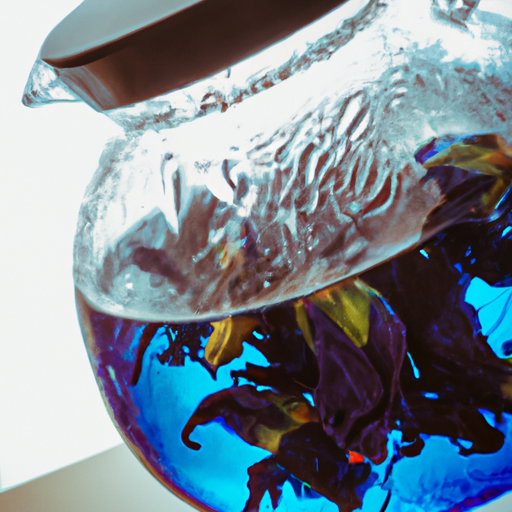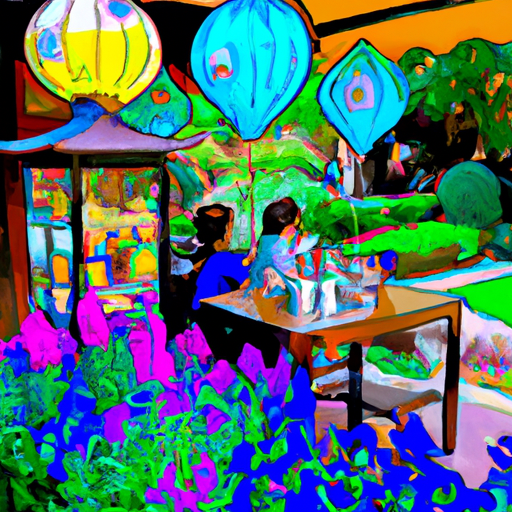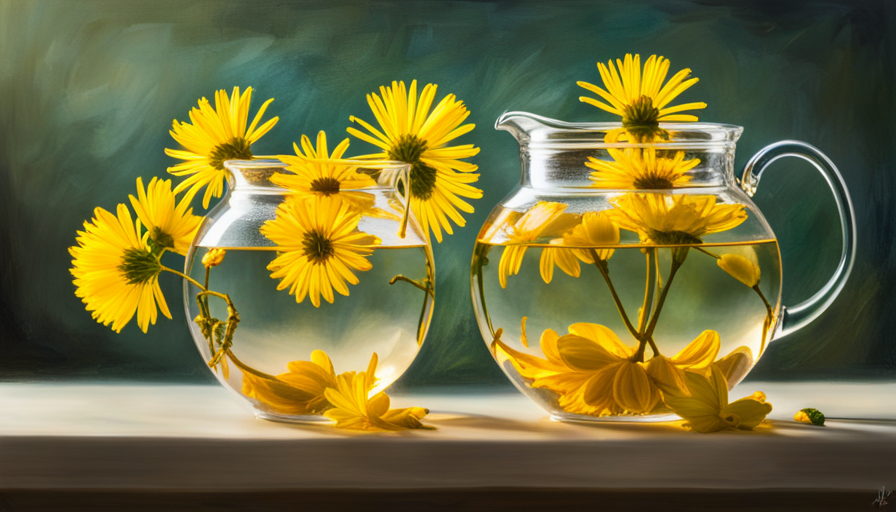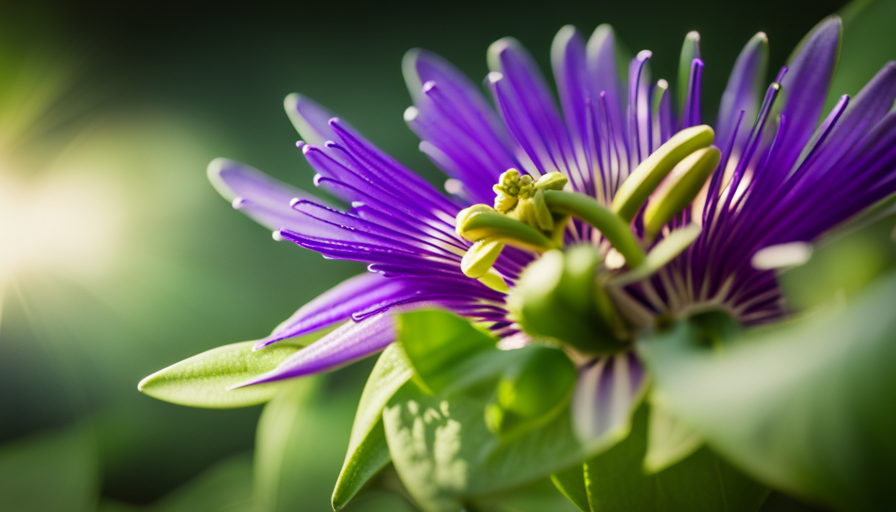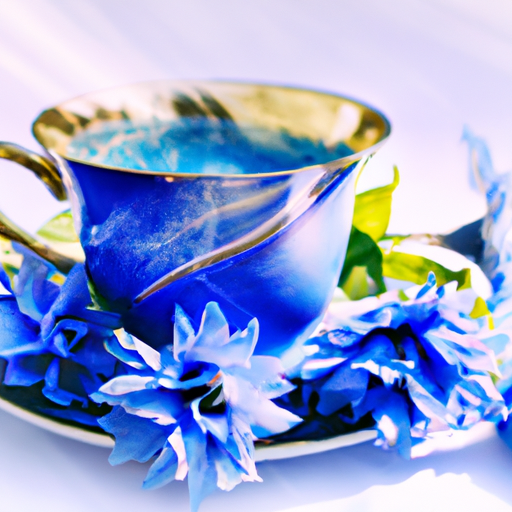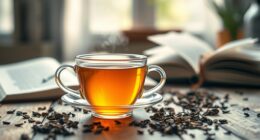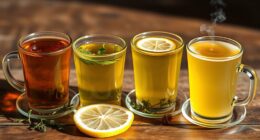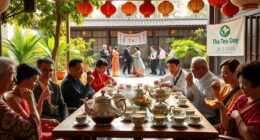Have you ever wondered how to make a vibrant and refreshing cup of blue flower tea? Look no further, because I’m here to guide you through the process step by step.
Blue flower tea, derived from the petals of various blue flowers, is not only visually stunning but also packed with health benefits. From its calming properties to its rich antioxidants, this tea is a must-have in every tea lover’s collection.
To make this delightful beverage, you will need a few simple ingredients and some basic equipment. By following my expert instructions, you’ll be able to steep the tea to perfection, ensuring a beautiful blue hue and a soothing aroma.
So, let’s get started and unlock the secrets of making blue flower tea that will impress your friends and leave you feeling refreshed.
Key Takeaways
- Blue flower tea is visually stunning and a must-have in a tea lover’s collection.
- Blue flower tea is packed with health benefits, including being rich in antioxidants and having calming properties.
- Blue flower tea is made using simple ingredients and basic equipment, with a delicate balance of steeping time.
- Blue flower tea can be enjoyed in various serving styles and recipes, such as Blue Flower Lemonade and Blue Flower Smoothie, allowing for unique and flavorful beverages.
Introduction to Blue Flower Tea
Are you ready to discover the incredible world of blue flower tea? Let me take you on a journey through the fascinating world of this unique beverage.
Blue flower tea, also known as butterfly pea flower tea, is not only visually stunning with its vibrant blue hue, but it also offers a range of health benefits. Packed with antioxidants, it helps boost the immune system and promotes overall well-being.
This tea has a rich history and cultural significance in Southeast Asia, where it’s been used for centuries in traditional medicine and culinary practices.
Now that you have a brief overview of the health benefits and historical importance of blue flower tea, let’s move on to the next step: gathering the ingredients needed to make this delightful brew.
Gather the Ingredients
Once you’ve got all the necessary ingredients, it’s smooth sailing to brew a delightful cup of this enchanting beverage. Blue flower tea is not only visually stunning, but it also offers a range of benefits.
Blue flowers such as butterfly pea, cornflower, and blue mallow are commonly used to make this tea. Each flower adds its unique flavor and color to the brew. Butterfly pea imparts a vibrant blue hue, cornflower adds a delicate floral note, and blue mallow brings a subtle sweetness. These flowers are not only beautiful but also packed with antioxidants and anti-inflammatory properties. So, sipping on a cup of blue flower tea can do wonders for your health.
Now that you know the benefits and the types of flowers used, let’s move on to preparing your tea infuser.
Prepare Your Tea Infuser
Get ready to brew your enchanting cup of blue flower tea by preparing your handy tea infuser. There are different types of tea infusers available, such as stainless steel mesh balls, silicon infusers, and tea strainers. Each type has its own unique benefits, but they all serve the same purpose of allowing the tea leaves or petals to steep in hot water while keeping them contained.
Using a tea infuser ensures that you get a well-infused and flavorful cup of blue flower tea, as it allows the water to flow freely through the leaves or petals, extracting their natural color and aroma. Once your tea infuser is ready, you can move on to the next step of steeping the tea, which is crucial for achieving the perfect flavor and color.
Steep the Tea
As the tea infuser embraces the hot water, a magical transformation occurs, infusing the liquid with the vibrant essence of the delicate blue blossoms. Steeping blue flower tea requires a delicate balance of time to achieve the perfect infusion.
It’s recommended to steep the tea for approximately 5-7 minutes to extract the maximum flavor and benefits. This duration allows the water to extract the natural colors and flavors from the flowers, resulting in a beautiful blue hue and a subtle floral taste. Steeping for too long may result in a bitter taste, while steeping for too short a time may result in a weaker flavor.
The longer steeping time allows the water to fully absorb the antioxidants and other beneficial compounds present in the blue flowers. It’s important to find the right balance to enjoy the optimal taste and benefits of blue flower tea.
Transitioning into the next section, once the steeping time is complete, it’s time to strain and serve the tea.
Strain and Serve
When you’ve achieved the perfect infusion, it’s time to strain the tea, allowing the vibrant essence to flow freely, and then serve it, inviting the delicate flavors to dance upon your taste buds.
Here are three discussion ideas to consider when straining and serving blue flower tea:
-
Different types of tea infusers: Explore the various options available, such as mesh balls, tea filters, or even traditional teapots with built-in strainers. Each infuser method offers a unique experience, allowing you to customize the brewing process to your liking.
-
Health benefits of blue flower tea: Dive into the numerous health benefits associated with blue flower tea, such as its antioxidant properties, potential stress-relieving effects, and ability to support digestive health. Discover how incorporating this vibrant brew into your daily routine can contribute to your overall well-being.
-
Serving suggestions: Experiment with different serving styles to enhance your tea-drinking experience. Consider adding a squeeze of lemon or a drizzle of honey to complement the floral notes. You can also serve it over ice for a refreshing twist on a hot day.
As you finish straining and serving your blue flower tea, it’s time to explore how to store and preserve the remaining brew, ensuring that its remarkable flavors and benefits are preserved for future enjoyment.
Store and Preserve
To keep the essence of your vibrant brew alive, imagine your tea as a delicate butterfly and gently place it in an airtight container, allowing it to rest and preserve its flavors for future sips of pure bliss.
Proper storage techniques are crucial to maintain the quality of blue flower tea. The tea should be kept away from direct sunlight and stored in a cool, dry place to prevent moisture from affecting its taste and aroma. Additionally, it’s recommended to store blue flower tea away from strong-smelling items, as it easily absorbs odors.
By following these storage guidelines, you can extend the shelf life of your blue flower tea and enjoy its health benefits for an extended period.
Now, let’s dive into the exciting world of experimenting with blue flower tea recipes.
Experiment with Blue Flower Tea Recipes
Let’s get creative and try out some delicious recipes using the enchanting blue flower infusion! Blue flower tea not only adds a beautiful hue to your drinks, but it also offers numerous health benefits. By exploring flavor combinations, you can create unique and flavorful beverages that are both refreshing and good for you.
Here are some ideas to get you started:
-
Blue Flower Lemonade: Combine blue flower tea with freshly squeezed lemon juice and a touch of honey for a tangy and refreshing twist on traditional lemonade.
-
Blue Flower Iced Tea: Brew blue flower tea and chill it in the refrigerator. Serve over ice with a squeeze of lime for a cool and revitalizing summer drink.
-
Blue Flower Smoothie: Blend blue flower tea with frozen berries, banana, and a splash of coconut milk for a nutritious and vibrant smoothie packed with antioxidants.
-
Blue Flower Mocktail: Mix blue flower tea with sparkling water, a splash of cranberry juice, and a squeeze of lime. Garnish with fresh mint leaves for a non-alcoholic, fizzy, and sophisticated drink option.
Experimenting with blue flower tea recipes allows you to discover new and exciting flavor combinations while reaping the health benefits this magical infusion has to offer. So grab your ingredients and let your imagination run wild!
Frequently Asked Questions
Can blue flower tea be made with dried flowers instead of fresh ones?
Yes, blue flower tea can be made with dried flowers instead of fresh ones. Dried flowers have the benefit of a longer shelf life and can still deliver the beautiful blue color. As for alternative sweeteners, options like honey or stevia can be used.
How long does blue flower tea stay fresh after it is brewed?
The shelf life of brewed blue flower tea varies depending on storage methods. When stored properly in an airtight container in the refrigerator, it can stay fresh for up to 3 days, preserving its flavors and beneficial properties.
Are there any health benefits associated with drinking blue flower tea?
Blue flower tea has been found to improve sleep quality and aid in relaxation. Studies have shown that the natural compounds in blue flowers have a calming effect on the mind and body, promoting a restful night’s sleep.
Can blue flower tea be sweetened with honey or other sweeteners?
Yes, blue flower tea can be sweetened with honey or other natural sweeteners. Honey is a popular choice due to its natural sweetness. Alternatively, you can use stevia, agave nectar, or maple syrup as alternative sweeteners for blue flower tea.
Can blue flower tea be consumed cold or is it meant to be served hot?
Blue flower tea can be enjoyed both cold and hot. To prepare it cold, steep the flowers in cold water for a few hours. For a hot cup, steep the flowers in hot water for 5-10 minutes.
Conclusion
After exploring the wonderful world of blue flower tea, I can’t help but be amazed by its stunning color and unique flavor. The process of making this tea is simple yet intriguing, as each step allows the flavors to infuse and blossom.
As I sip on a cup of this exquisite brew, I can’t help but wonder what other delightful recipes await. The possibilities seem endless, and I can’t wait to embark on this journey of experimentation and discovery.
Join me as we unlock the secrets of blue flower tea and indulge in its captivating allure.

